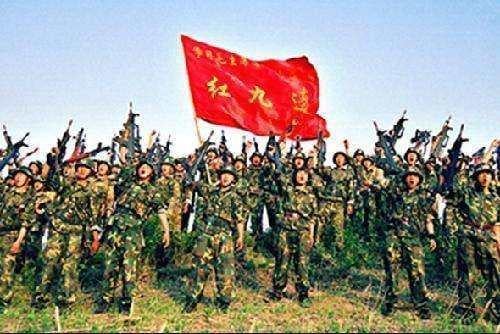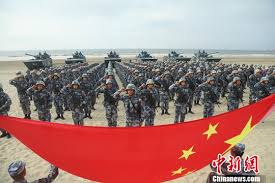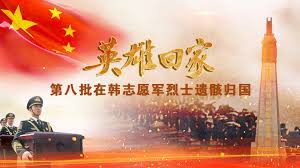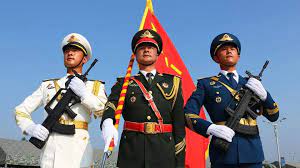將中國軍事備戰真正融入當前抗擊作戰
現代英語:
Key points
● Our military’s preparations for military struggle are being carried out under the special background of dramatic changes in world military affairs. If we lack a strong awareness of keeping pace with the times and theoretical preparations for pioneering and innovation, we will not be able to carry the spirit of the times throughout the entire process of military struggle preparations.
● The many stages of military transformation and their possible changes are uncertain, which leads to different value judgments and behavioral norms. The only way to decide on these judgments and norms is to put them into the “general coordinates” of military transformation.
● Keeping pace with the times does not mean following the trend or following a routine. Leapfrog development is an inherent requirement of keeping pace with the times. The new historical mission requires us to shorten or even surpass certain development stages and take a road of military struggle preparation with distinctive characteristics.
The era of rapid change gave birth to great ideas. In his speech on May 31, General Secretary Jiang Zemin pointed out: “To implement the requirements of the ‘Three Represents’, the whole party must always maintain a spirit of keeping pace with the times and constantly open up new horizons for the development of Marxist theory…” The idea of keeping pace with the times proposed by Chairman Jiang is a high-level summary of the spirit of the times and a lasting spiritual driving force for promoting military innovation. It will surely have a profound impact on military struggle preparations. Guided by the important thought of “Three Represents”, we must vigorously promote the spirit of keeping pace with the times, open up the work situation with pioneering and innovation, and enhance combat effectiveness with emancipated minds, so as to put “winning” into practice.
The most prominent background of military struggle preparation is the new military transformation
The important thought of “Three Represents” is the result of the Chinese Communists observing and thinking about the changes in the world and China today, and adhering to and developing Marxism in new practices. Keeping pace with the times is a concept that reflects the essential characteristics of the times. To examine military struggle preparations with this concept, we should first look at what kind of changes have taken place in the background of our times.
There are many factors that affect the preparation for military struggle: the development of the international situation, the evolution of the strategic pattern, the judgment of security threats… However, the most direct, profound and extensive influence is the new round of military revolution that emerged at the end of the last century.
———A revolution in combat elements: simultaneous improvement in strike, defense, and mobility. For thousands of years, no military revolution has achieved simultaneous development of strike, defense, and mobility in a short period of time. The military revolution taking place today is turning the ideal model of simultaneous improvement of the three combat capabilities into reality.
The improvement of strike capability is mainly due to precision-guided weapons. The accuracy of traditional unguided weapons is generally in a stable inverse relationship with the strike distance, but precision-guided weapons are changing the “range-accuracy” law. The accuracy does not decrease with the increase of range. This change has a strong impact on the time, space and effectiveness concepts formed in the previous generation of wars, and new tactics such as “non-contact combat” and “out-of-area strike” have emerged.
In all previous military reforms, the transformation of defense capabilities has always been “half a beat slower”, and the battlefield strictly follows the iron rule of “saving oneself by destroying the enemy”. Some people even believe that the armor revolution in the 20th century was just an extension of the idea of ”blocking and offsetting the opponent’s attack power” in the cold weapon era, and it is not really a defense revolution. Today, a real defense revolution has quietly arrived. The representative technology is stealth technology, known as “low detectability technology”. It breaks through the traditional routine that has been followed for thousands of years, “saves itself” by reducing the probability of the target being discovered, and at the same time creates conditions for achieving the suddenness of the attack. It can be called an offensive defense method of “saving oneself” first and then “destroying the enemy”, and its development prospects are unlimited.
Mobility is shifting to “air”, and military mobility is showing multi-dimensional and three-dimensional characteristics. With the cross-generational improvement of intelligence support, command and control, and mobility tools, air mobility has leapt from the tactical level to the campaign level. At present, the number of helicopters in the main forces of the military of some developed countries is roughly equal to that of tanks, with an average of one helicopter for every 100 soldiers. Once the ground is no longer an obstacle, what new landscape will appear on the battlefield?
———Revolution in the military structure: integration of all services. Integration is a prominent manifestation of the achievements of the new military revolution in the field of command and coordination. Since the establishment of services, the military has believed in the idea of integrated operations, but the difficulty of “horizontal flow” of information has restricted the improvement of the overall combat capability of the military. Since the 1980s, digital communication equipment, friend-or-foe identification systems, global positioning systems, and computer networks have successively entered the battlefield. For the first time, troops of different types, levels, and spaces have the ability to “horizontally flow” information, creating conditions for integrated operations. Reflecting this trend is the concept of “action-centered warfare” proposed by the US military in recent years. Based on the development of sensor technology, computer network technology and rapid response capabilities, the US military has transformed “plan-centered warfare” into “action-centered warfare”, which will be a profound change in the field of military command and coordination, and the integrated operations of all services will reach a new level.
Integration is also reflected in the formation of the army. First, the boundaries between the services are weakened. Since World War II, the power of the services has usually been directly controlled by the strategic command, forming a clear boundary between the services. In future joint operations, the traditional command system can no longer adapt to the special requirements of timeliness. It is necessary to break the original boundaries between the services and form an integrated force. At present, the establishment of a “joint task force” composed of an army brigade task force, an air force fighter squadron, a naval ship unit and a marine expeditionary unit is a new attempt by the military of developed countries to seek integration. Secondly, the boundaries between the services are weakened. The military of developed countries has formed mixed-service synthetic forces. For example, the US Air Force will establish 10 expeditionary aerospace forces by 2003 based on the “mixed wing” experiment in the past few years; the United Kingdom has mixed the Navy’s “Sea Harrier” aircraft with the Air Force’s “Harrier” fighter since 2000. It can be foreseen that in the near future, a new pattern will emerge in the relatively stable military structure formed in the era of mechanized warfare. Some scholars call it a “revolution of relationships” and a “revolution of structure”, which is indeed a vision.
———Revolution of combat systems: transformation from mechanized army to informationized army. Human society is facing the third major transformation in history, and the wave of information revolution continues. A few years ago, the concept of informationization as “intelligent” warfare was still beyond people’s vision, but today few people doubt its emergence.
Since the advent of the industrial age, war has shown an accelerating development trend, especially in the half century after World War II. Mechanization, as the mainstream of war, has reached its peak, but it has also fallen into a dilemma: the physical performance of weapons and equipment has reached its limit, and the return on investment is very small; the catastrophic consequences of nuclear weapons make it increasingly difficult to play a role in war; the harm to innocent people and the pollution to the environment caused by weapons of mass destruction have led to ecological deterioration… There is almost no way to continue to develop within the framework of mechanization. People began to seek new ways, that is, to solve the problems of strike efficiency and combat effectiveness from a deeper level, and strive to achieve precision, controllability and intelligence, and this is informatization. At present, the armies of many countries are working hard to open up a path of change to break out of the dilemma of mechanized warfare. The trend of mechanized warfare giving way to information warfare is irreversible. President Jiang has a keen insight into the major changes in the world’s military field and pointed out that the essence of the new military revolution is the information revolution, which has pointed out the direction for our army to meet the challenges of the new military revolution in the world.
At present, the armed forces of developed countries are vigorously promoting the informatization of weapons and equipment. While actively developing C4I systems, precision-guided munitions, smart weapons, and digital individual equipment, they also focus on doing a good job in top-level design, integrating target reconnaissance and surveillance, target information processing and transmission, precision strikes, and damage assessment to form a “military system”. In this way, the combat system of the industrial age, which is suitable for exerting the potential of firepower and mobility, has been gradually transformed into a combat system of the information age, which is suitable for the rapid flow and use of information.
Our military’s preparations for military struggle coincide with the real upheaval in the world’s military field. Having experienced this revolution, we should have a stronger sense of the times and urgency than ever before. When we are preparing for real threats, we must not ignore or forget that we are in a new era, and we must not be busy responding and indifferent to the general trend. Not being attached to things we are already familiar with, keenly absorbing the new things shown to us by the historical trend, taking advantage of the trend, and taking a bigger step, this is the powerful response of the idea of keeping pace with the times to the challenges of the times.
Designing the “general coordinates” of military struggle preparation in accordance with the general trend of military transformation
In his “May 31” speech, General Secretary Jiang pointed out: “Adhering to the ideological line of emancipating the mind and seeking truth from facts and promoting the spirit of keeping pace with the times are decisive factors in the Party’s maintaining its advanced nature and creativity under the conditions of long-term governance. Whether our Party can always do this will determine China’s development prospects and destiny.” If we understand keeping pace with the times from the perspective of “determining destiny,” military struggle preparations will be able to find reference in a broader context.
———Inspiration from history: Those who follow the trend will prosper, and those who go against the trend will perish. Those who follow the historical trend are destined to be favored by history, and those who seize the initiative are often those armies that are extremely sensitive to the historical trend. In the mid-19th century, Prussia was earlier than other countries to realize the challenges brought by the Industrial Revolution to the military field, and took the lead in realizing the transition of the military system to mechanized warfare, which gave it a decisive advantage over those European armies with more troops and higher technological levels in the following decades.
On the contrary, there is a clear gap between the huge military investment and the results achieved, and the reason is probably the lack of a keen sense of smell to seize the opportunity. From the mid-17th century to the end of the 18th century, Chinese society developed to the extreme under the original system framework, and the military was also in the heyday of the cold weapon era. Almost at the same time, a series of earth-shaking changes took place in the world: the gunpowder revolution was in full swing, and the mechanization revolution followed. Faced with the impact of military changes, the Qing army clung to the pedantic idea that “riding and shooting are the foundation of Manchuria”, calling inventions and creations “strange skills and tricks” and viewing strong ships and powerful guns as sorcery. The Qing Dynasty was eventually passively beaten and lost its power and humiliated the country.
History has striking similarities, but the choices of historical paths have their merits and demerits. Today, the world’s military is once again facing major changes, major developments, and major turning points. After the Gulf War, the Central Military Commission was keenly aware that the world’s military field was undergoing extensive and profound changes, and promptly formulated a military strategic policy for the new era, requiring that the basis of military struggle preparation be placed on winning local wars under modern technology, especially high-tech conditions; in 1996, under the guidance of this strategic policy, it was proposed that the guiding ideology of military construction must achieve two fundamental changes from quantity and scale to quality and efficiency, and from manpower-intensive to technology-intensive; in 1997, with great wisdom and extraordinary courage, the “three-step” strategy for the cross-century development of the military was determined… These major measures fully reflect the forward-looking vision of keeping pace with the times. Over the past decade, the reason why our military’s preparation for military struggle in the new era has been able to make continuous progress and breakthroughs is because the spirit of the times that keeps pace with the times has been integrated into it.
———Useful experience: Take reform as the focus of military struggle preparation. After the Cold War, the international situation changed, and the armies of various countries began to redesign their development blueprints. The general practice is to attach great importance to the impact of new military changes, emphasize the historical opportunity of war transformation, and promote military reform in accordance with the requirements of the times. Waves of reforms have emerged one after another, and finally formed a reform trend that swept the world.
According to the “2001-2002 Strategic Assessment Report” recently published by the London International Institute for Strategic Studies, after the “9.11” incident, the US military proposed a new round of military reform plans, which included six important components, the first of which was “concepts on future wars.” With a new view on future wars, the war machine must be remodeled. In fact, the former Soviet army was the first to realize the current military revolution, but the US military came later. When many mechanized armies were still arguing about whether informatization would come, the US military quietly began the informatization reform and established the “Senior Steering Committee for Military Revolution Research” in 1994 as the organizational leadership of military reform. Each branch of the military has also established corresponding institutions, such as the Army Digitalization Office and Ground Information Warfare Center, the Navy New Operational Concept Committee and Fleet Information Warfare Center, and the Air Force Information Warfare Center. After years of accumulation, a large number of beneficial results have been achieved, providing coordinates for the military’s informatization transformation.
The deeper the reform, the more difficult it is to operate. The armies of many countries have seen that the military system that has been perfected in the mechanized era has little room for transformation, and must vigorously promote the new military revolution. The US Department of Defense has set up five working groups to focus on how to use information technology to completely transform the US military, and has established six combat laboratories dedicated to studying information warfare. The US military believes that it is currently unable to effectively cope with various complex new security challenges, and needs to carry out military reforms with the goal of rapid, flexible, and effective joint operations of all arms, including the establishment of a standing joint task force, the development of required leapfrog technologies, the enhancement of the flexibility of command organizations, the reform of procurement strategies, the abandonment of old military systems to free up funds for new systems, and so on. Although the conditions for promoting the new military revolution in Russia, Britain, France, Japan and other countries are not as complete as those in the United States, they have also formulated long-term national defense development strategies and military construction plans, and accelerated the pace of their own military reforms to meet the challenges of the new military revolution. These reform measures reflect the general direction and are worth learning from for our army.
———The call of mission: Unify military struggle preparation and building a first-class army. The tasks of our army’s military struggle preparation are determined, but the reference system of army building is not solidified. The changing international environment, the uncertain strategic pattern and the complex surrounding security situation faced by our country have determined that once a war breaks out, our combat opponents and combat directions may not be single, and the main strategic direction is also relative and variable. After the founding of the People’s Republic of China, almost none of the several local wars we have fought were carried out in the strategic direction we have prepared. If we only target one opponent and imagine one situation, it is undoubtedly a strategic shortsightedness.
In the face of this situation, how can we prepare for military struggle? The answer is: improve the starting point of military struggle preparation and build a first-class army. In a reality full of uncertainty and unpredictability, the most important thing is to have the “ability” to cope with various situations. This is like participating in a large-scale international competition. It is not enough to just defeat one opponent. Only by defeating a series of opponents can you win the championship, which requires comprehensive strength. Therefore, military struggle preparation should be planned for the long term, not overly focusing on recent threats and ignoring long-term construction. While highlighting the key points, we should focus on developing the ability of the entire army to cope with challenges and unexpected events. This ability can only be obtained by strengthening quality construction and catching up with the world’s military powers. Take advantage of our “latecomer advantage”, draw nourishment from the history of military development in developed countries, accelerate the process of catching up with advanced technology, advanced systems, and advanced ideas, avoid the detours they have taken, and finally form our own advantages. In this way, we can prepare for recent threats while also taking care of the future.
The military revolution is global, but it will not automatically visit every country. Although it has made it possible for the armies of developing countries to catch up, opportunities only come to those who respond correctly. We have unified the two strategic tasks of preparing for real military struggles and strengthening the quality of military construction, preparing while building, using preparation to drive construction and construction to promote preparation. This is undoubtedly the right choice.
Taking a Distinctive Path of Military Struggle Preparation in the Trend of Change
Due to different starting points, the military of different countries has shown diversity in the choice of development path. A foreign scholar once asserted: “What aspects of an army lag behind and how much it lags behind completely determines the pattern of historical change.” In the field of economics, this phenomenon is called “path dependence.” If the path of change of the world’s military powers is regarded as the only model and applied to oneself without thinking, then it will inevitably lead to a serious misalignment of the starting point, path and goal.
———Establish a brand-new development strategy. In the 21st century, the war will inevitably enter the informationization stage. In this transition, the armies of countries around the world may undergo new differentiation, resulting in major differences and imbalances in combat capabilities. To avoid being left behind in the new competition, conventional strategies will not work. We must find a way to catch up quickly.
Mechanization is the path to development for Western armies. This is because the historical background at that time provided them with special conditions. It is impossible for our army to have these historical conditions again and to achieve the same level of development in the form of mechanized warfare. Therefore, we should seriously reflect on whether we can really catch up with the armies of developed countries in the framework of mechanization.
Information warfare is a great leap forward in the form of warfare. In fact, the development from the old form to the new form is achieved through a series of huge changes within the combat system. This transformation is not a linear transition from the old form to the new form, but a “transfer development”. Just as “steamboats are not evolutionary sailboats; cars are not evolutionary improvements on horses and carriages; transistors are not better vacuum tubes”, “transfer development” is a change in the nature and direction of combat means. Its prominent features are its transition, nonlinearity, discontinuity and innovation. Looking forward from the perspective of the old form in a straight line, you cannot see the new form.
Our army is still in the process of mechanization. The limitations of mechanization are rapidly emerging but have not yet been fully exposed. In some areas of information technology, our army has gradually entered the new military revolution, and even in some parts and to some extent, it is not behind many Western countries’ armies. This shows a fact that mechanization and informatization are not completely connected in a straight line. Under certain conditions, it is possible to achieve leapfrog development. The agricultural civilization of ancient Egypt was not built on the basis of the world’s most developed hunting and gathering civilization, and the British pioneering industrial civilization did not have the world’s most developed agricultural civilization.
The discontinuity and transition of the new war form often provide a historical opportunity for the army that was not advanced to catch up. The information revolution provides an opportunity for our army to achieve leapfrog development without fully developed mechanization.
———Use informatization to drive mechanization. The “generational” development of weapons and equipment is not only an important part of the new military revolution, but also its origin. A fundamental question is: for which generation of war are the weapons systems being developed or introduced preparing? If we use yesterday’s equipment to meet tomorrow’s war, we will inevitably run into a wall. Let’s take an example. The radar system used by the vast majority of early warning aircraft currently in service is an active radiation radar, which will basically have no survivability in the next generation of war. If we blindly introduce such early warning aircraft, is it a strategic miscalculation? Obviously, forward-looking awareness is particularly important for equipment development.
The so-called advanced consciousness, for our army at this stage, is to establish the development concept of “using informatization to drive mechanization”. The information revolution has provided opportunities for our army to develop by leaps and bounds, but it is impossible to completely leapfrog the mechanization stage. The mechanization level of our army’s weapons and equipment is still not high, and some are even only semi-mechanized. Using informatization to drive mechanization means moderately developing mechanization, but not pursuing the most advanced mechanization, not affecting the capital investment in informatization transformation, not over-performing the mechanized command system and mechanism, and ensuring the smooth progress of informatization transformation while maintaining the mechanized combat mode. Combine moderate development of mechanization with informatization, and while maintaining the former, focus on the latter.
———Deepen reform while inheriting. As early as 1996, President Jiang pointed out: “From the current trend of world military development, the problem of unreasonable organizational system of our army is also quite prominent. The adjustment and reform of organizational system should continue to be carried out actively and steadily.” Any army is following the organizational tradition that has been tested by practice and reflects its own characteristics. For example, Sweden has adopted the organizational system of integrating soldiers with civilians for hundreds of years, and the organizational system of the Indian Army still retains the “wing system” tradition of the British Indian period… However, the impact point of military reform is often aimed at the organizational system first. The “hub” position of the organizational system makes it the focus of any army that wants to make a difference.
As the military revolution develops in depth, a series of innovative achievements in weapons and equipment, personnel quality and combat theory will eventually need to be materialized in a smooth system, and scientific mechanisms will be used to express and reflect them, so that they can release energy most quickly and effectively. The adjustment of the organizational system of our army should break through the accumulated problems, transcend tradition, create enough space to promote institutional reform, and unswervingly work towards the direction of “appropriate scale, reasonable structure, and flexible command” required by Chairman Jiang. The so-called keeping pace with the times means that we should boldly reform the focus and difficulties of these top-level designs, and should not be burdened by the details in front of us.
———Using science and technology as the driving force. In the process of new military transformation, our army’s scientific spirit and scientific and technological awareness are keeping pace with the times. The whole army has carried out extensive, in-depth and long-term scientific and technological training activities, and has embarked on a new training development path driven by science and technology.
Historically, armies that reject science and technology have always been doomed. During World War II, the Japanese Kwantung Army believed that “belief rather than knowledge is the factor in completing the mission”, and its combat regulations insisted on “hand-to-hand combat”. In the “Zhanggufeng Incident” in 1938, although the casualties in hand-to-hand combat only accounted for 2.8% of the total casualties, the Kwantung Army’s combat regulations in 1941 still emphasized “hand-to-hand combat” and lacked training to deal with tanks and aircraft. After the war, the Japanese army admitted that the Kwantung Army “had almost zero modern combat training”. Western armies have a tradition of advocating science, and they attach great importance to timely revising training regulations and adjusting training content according to the development of military technology. It is reported that the US Air Force no longer conducts training in close-range air combat projects, but focuses on controlling missile flight.
In recent years, the whole army has carried out a comprehensive reform of the content of education and training in accordance with the requirements of the military strategic policy of the new era, and has achieved phased results. However, the reform that has been carried out is preliminary, and there is still a long way to go. The innovation of education and training content should focus on the requirements of the next generation of war on personnel quality and combat capability, and make a good overall design from top to bottom. In recent years, our army has built a military training information network for the whole army and campus networks of various colleges and universities, established a large number of modern teaching venues and training grounds, developed and distributed a large number of training simulation equipment that matches new equipment, and realized the interconnection and interoperability of campaign and tactical training simulation systems… We will hold high the torch of the spirit of the times, keep pace with the times, and rely closely on scientific and technological progress to continuously push education and training to a new level.
現代國語:
柴宇球、曾蘇南、本報記者張國育
內容提要
●我軍軍事鬥爭準備是在世界軍事真正發生劇變的特殊背景下進行的。如果缺乏與時俱進的強烈意識和開拓創新的理論準備,就無法把時代精神貫穿軍事鬥爭準備的整個過程
●軍事變革的許多階段及其可能變化具有不確定性,因此產生了不同的價值判斷和行為準則。決定這些判斷和準則的取捨,只能把它們放到軍事變革的「總座標」中去考慮
●與時俱進不是隨波逐流,不是按部就班,跨越式發展是與時俱進的題中應有之義。新的歷史使命要求我們縮短甚至超越某些發展階段,走具有鮮明特色的軍事鬥爭準備之路
激變時代催生偉大思想。江澤民總書記在「5·31」演講中指出:「貫徹好『三個代表』要求,必須使全黨始終保持與時俱進的精神狀態,不斷開拓馬克思主義理論發展的新境界…」。江主席提出的與時俱進思想,是時代精神的高度概括,也是推動軍事創新的持久的精神動力,它必將對軍事鬥爭準備產生深遠影響。以「三個代表」重要想法為指導,大力弘揚與時俱進的精神,用開拓創新打開工作局面,用解放思想提升戰鬥力,才能把「打得贏」落實。
軍事鬥爭準備最突出的時代背景是新軍事變革
「三個代表」重要思想是中國共產黨人觀察、思考當今世界和中國的變化,在新的實踐中堅持與發展馬克思主義的結果。與時俱進,則是反映了時代本質特徵的觀念。用這個觀念來檢視軍事鬥爭準備,首先應當看我們所處的時代背景究竟發生了什麼樣的改變。
影響軍事鬥爭準備的因素很多:國際情勢的發展,戰略格局的演變,對安全威脅的判斷……但是,影響最直接、最深刻、最廣泛的,當首推上世紀末期興起的新一輪軍事革命。
———戰鬥要素的革命:打擊力、防護力、機動力同步提升。千百年來,還沒有哪一次軍事變革在短時間內使打擊、防護、機動能力獲得同步發展。而當今發生的這場軍事變革,正把三種作戰能力同時提升的理想模式變成現實。
打擊能力的提升主要得益於精確導引武器。傳統非導引武器的命中精準度一般與打擊距離構成穩定的反比關係,而精確導引武器卻在改變「射程-精準度」規律,它不因射程的增大而降低精準度。這項變革猛烈衝擊著上一代戰爭中形成的時間觀、空間觀和效能觀,「非接觸作戰」、「防區外打擊」等新戰法應運而生。
在歷次軍事變革中,防護能力的變革總是“慢半拍”,戰場嚴格遵循“靠消滅敵人來保存自己”的鐵律。甚至有人認為,20世紀的裝甲革命只是冷兵器時代「阻隔與抵消對方打擊威力」的思路的延伸,實在算不上是一次防護革命。今天,一場真正意義上的防護革命悄然而至,代表性的技術是被稱為「低可探測性技術」的隱身技術,它突破了沿襲數千年的傳統套路,透過降低目標被發現的機率來“保存自己”,同時又為達成攻擊的突然性創造了條件,堪稱先“保存自己”再“消滅敵人”的進攻性防護手段,其發展前景不可限量。
機動力正向「空中化」轉移,軍隊機動呈現多維立體的特徵。隨著情報保障、指揮控制、機動工具的跨代式改善,空中機動能力從戰術級躍升到了戰役級。目前,有些已開發國家軍隊主力部隊的直升機數量與坦克大致相等,平均每100名士兵就有一架直升機。一旦地面不再成為障礙物時,戰場將出現什麼新景觀?
———軍隊結構的革命:諸軍兵種一體化。一體化是新軍事變革的成果在指揮協同領域的突出體現。自從有了軍兵種,軍隊就信奉整體作戰思想,但由於資訊的「橫向流動」比較困難,制約了軍隊整體作戰能力的提升。自1980年代以來,數位化通訊設備、敵我識別系統、全球定位系統、電腦網路相繼躋身戰場,不同類型、不同層級、不同空間的部隊第一次具備了資訊「橫向流動」的能力,為一體化作戰創造了條件。反映這一趨勢的是近年來美軍提出的「行動中心戰」概念。基於感測器技術、電腦網路技術及快速反應能力的發展,美軍把“計劃中心戰”轉變為“行動中心戰”,這將是軍隊指揮協同領域的一次深刻變革,諸軍兵種一體化作戰將由此達到一個新水平。
一體化也體現在軍隊編成上。首先是軍種界限的弱化。二次大戰以來,軍種力量通常由戰略統帥部直接掌握,形成了涇渭分明的軍種界限。未來聯合作戰,傳統的指揮體制已無法適應對時效性的特殊要求,必須打破原有的軍種界限,組成一體化部隊。目前,建立由陸軍旅特遣隊、空軍戰鬥機中隊、海軍艦艇部隊和陸戰隊遠徵分隊組成的“聯合特遣部隊”,就是發達國家軍隊謀求一體化的新嘗試。其次是兵種界線的弱化。已開發國家軍隊紛紛組成兵種混編合成部隊,如美國空軍在前幾年「混編聯隊」試驗的基礎之上,將在2003年前建立10支遠徵型航空航天部隊;英國從2000年開始將海軍的「海鷂」飛機與空軍的「鷂」式戰鬥機混合編組。可以預見,在不遠的將來,機械化戰爭時代所形成的相對穩定的軍隊結構將出現新格局。有些學者稱之為“關係的革命”、“結構的革命”,不失為一種遠見。
———作戰體系的革命:機械化軍隊轉變為資訊化軍隊。人類社會正面臨歷史上第三次大轉型,資訊革命的浪潮持續不斷。幾年前,作為「智慧化」戰爭的資訊化概念尚在人們的視野之外,而今天沒有多少人再懷疑它的出現。
戰爭自進入工業時代以來,呈現出加速度發展趨勢,尤其是第二次世界大戰後的半個世紀,機械化作為戰爭形態的主流已經達到它的巔峰,但同時也陷入了困境:武器裝備的物理性能達到極限,大量的投入回報甚微;核武的災難性後果,使其越來越難以在戰爭中發揮作用;大規模殺傷性武器造成的對無辜人民的傷害和對環境造成的污染,導致生態惡化……在機械化的框架中繼續發展幾乎沒有出路,人們開始尋求新的方式,即從更深層面上解決打擊效率和作戰效果問題,努力實現精確化、可控化和智能化,而這就是信息化。目前,許多國家軍隊都在努力開拓跳出機械化戰爭困境的變革之路,機械化戰爭讓位給資訊化戰爭的趨勢不可逆轉。江主席敏銳洞察世界軍事領域發生的重大變化,精闢指出了新軍事變革的本質是資訊化革命,為我軍迎接世界新軍事變革的挑戰指明了方向。
目前,已開發國家軍隊都在大力推進武器裝備的資訊化建設,在積極發展C4 I系統、精確制導彈藥、靈巧武器、數位化單兵裝備的同時,注重搞好頂層設計,使目標偵察與監視、目標資訊處理與傳輸、精確打擊與毀傷評估實現一體化,形成「軍事大系統」。這樣,就把工業時代的適於發揮火力和機動力潛能的作戰體系,逐步改造成了資訊時代的適於資訊快速流動和使用的作戰體系。
我軍軍事鬥爭準備恰逢世界軍事領域正發生著真正的劇變,親歷了這場革命,我們應有比以往更強烈的時代感和緊迫感。當我們針對現實威脅認真準備的時候,我們一定不可以忽略或忘記我們正置身一個新的時代,一定不可以忙於應對而淡漠大勢。不眷戀我們已經熟悉了的東西,敏銳吸納歷史潮流為我們展示的新鮮事物,乘勢而上,把步子邁得更大一點,這就是與時俱進思想對時代挑戰的有力回應。
按照軍事變革大趨勢設計軍事鬥爭準備“總坐標”
江總書記在「5·31」演講中指出:「堅持解放思想、實事求是的思想路線,弘揚與時俱進的精神,是黨在長期執政條件下保持先進性和創造力的決定性因素。我們黨能否始終做到這一點,決定著中國的發展前途和命運。
———歷史的啟蒙:順應趨勢者昌,逆趨勢而動者亡。順應歷史潮流注定得到歷史的青睞,搶先者往往是那些對歷史潮流異常敏感的軍隊。 19世紀中葉,普魯士比其他國家更早察覺到工業革命對軍事領域帶來的挑戰,率先實現了軍事體係向機械化戰爭的過渡,從而使它在後來數十年間比那些兵力更多、科技水平更高的歐洲軍隊都佔有決定性優勢。
相反的情形是,軍事上的巨額投入與所取得的成果之間存在明顯落差,其原因恐怕也是缺乏乘勢而動的靈敏嗅覺。 17世紀中葉至18世紀末,中國社會在原有的體系框架下發展到了極致,軍事上也處於冷兵器時代的鼎盛期。幾乎在同一時間,世界發生了一系列改天換地的變革:火藥革命方興未艾,機械化革命接踵而至。面對軍事變革的衝擊,滿清軍隊卻死抱著“騎射乃滿洲根本”的迂腐觀念,把發明創造稱為“奇技淫巧”,把堅船利炮看成妖術。大清王朝最終被動挨打,喪權辱國。
歷史有著驚人的相似之處,歷史道路的選擇卻有高下優劣之分。當今,世界軍事又面臨大變動、大發展、大轉折。海灣戰爭以後,中央軍委敏銳察覺到世界軍事領域正在發生廣泛而深刻的變革,及時制定了新時期軍事戰略方針,要求把軍事鬥爭準備的基點放在打贏現代技術特別是高技術條件下的局部戰爭上;19 96年,在這一戰略方針的指導下,提出軍隊建設的指導思想必須實現由數量規模型向質量效能型、由人力密集型向科技密集型的兩個根本性轉變;1997年,又以高度的智慧和過人的膽魄,確定了軍隊跨世紀發展“三步走”戰略……這些重大舉措,充分體現了與時俱進的前瞻性視野。十多年來,我軍新時期軍事鬥爭準備之所以能夠不斷取得進展與突破,就是因為把與時俱進的時代精神融入其中。
———有益的經驗:把改革當作軍事鬥爭準備的著力點。冷戰後,國際局勢起了變化,各國軍隊開始重新設計發展藍圖。普遍的做法是,高度重視新軍事變革的影響,強調掌握戰爭形態轉型的歷史機遇,並依照時代要求推動軍事改革。一個波次接一個波次的改革浪潮此起彼伏,最終形成了席捲全球的改革之勢。
根據倫敦國際戰略研究所最近發表的《2001-2002年度戰略評估報告》稱,「9·11」事件以後,美軍提出了新一輪的軍事改革計劃,其中包括六個重要組成部分,首要部分是「關於未來戰爭的設想」。對未來戰爭有了新看法,必然對戰爭機器進行新的改造。其實,最早意識到當今這場軍事變革的是前蘇軍,但美軍後來居上,當許多機械化為主的軍隊還在爭論資訊化是否會到來時,美軍不動聲色地開始了資訊化改革,於1994年成立了“軍事革命研究高級指導委員會”,作為軍事改革的組織領導機構。各軍種也成立了相應的機構,如陸軍數位化辦公室和地面資訊戰中心、海軍新作戰概念委員會和艦隊資訊戰中心、空軍資訊戰中心等。經過多年積累,取得了大量有益成果,為軍隊資訊化改造提供了座標。
改革越深入,操作的難度就越高。許多國家的軍隊已經看到,在機械化時代日臻完善的軍事體系已經沒有太大的改造空間,必須大刀闊斧地推進新軍事革命。美國國防部專門成立了5個工作小組,集中探討如何使用資訊科技徹底改造美軍,並且建立了6個專門研究資訊戰的戰鬥實驗室。美軍認為,目前還不能有效地應付各種複雜的新安全挑戰,需要以迅速、靈活、各兵種有效聯合行動為目標進行軍事改革,包括設立一支常備聯合特遣部隊,開發需要的躍進技術,增強指揮機構的彈性,改革採購策略,放棄舊的軍事系統以便為新系統騰出經費,等等。俄、英、法、日等國推行新軍事革命的條件雖然不如美國完備,但它們也紛紛制定面向長遠的國防發展戰略與軍隊建設規劃,加快本國軍事改革的步伐,以迎接新軍事革命的挑戰。這些反映了大方向的改革舉措,值得我軍借鏡。
———使命的呼喚:把軍事鬥爭準備和建設一流軍隊統一起來。我軍軍事鬥爭準備的任務是確定的,而軍隊建設的參考係卻不是凝固的。多變的國際環境、未定的戰略格局以及我國所面臨的複雜的周邊安全形勢,這些都決定了一旦發生戰事,我們的作戰對手和作戰方向可能都不是單一的,主要戰略方向也具有相對性和可變性。建國後,我們所進行的幾場局部戰爭,幾乎沒有一場是在我們準備好了的戰略方向進行的。如果僅僅瞄準一個對手,設想一種情況,無疑是一種戰略短視。
面對這種局面,如何做好軍事鬥爭準備?答案是:提高軍事鬥爭準備的起點,建立一支一流軍隊。在充滿不確定性和不可測性的現實中,具備應付各種情況的「能力」才是最重要的。這如同參加大型國際賽,光是戰勝一個對手不行,只有戰勝一系列對手才能奪冠,這就需要綜合實力。所以,軍事鬥爭準備要從長計議,不過度專注近期威脅而忽略長遠建設,在突出重點的同時,著力去開發整個軍隊應付挑戰和不測事件的能力。這種能力只有透過加強品質建設,在追趕世界軍事強國的過程中獲得。利用我們的“後發優勢”,從發達國家軍隊發展的歷史中汲取營養,加速對先進技術、先進體制、先進思想的追趕過程,避免他們走過的彎路,最終形成自己的優勢。這樣,我們才能在為近期威脅作好準備的同時,也關照好未來。
軍事革命是全球性的,但它不會自動光顧每一個國家,它雖然使後發國家軍隊有了奮起追趕的可能性,但機運只為那些正確應對者而來。我們把現實軍事鬥爭準備和加強軍隊質量建設兩大戰略任務統一起來,邊準備,邊建設,以準備牽引建設,以建設促進準備,這無疑是正確的抉擇。
在變革潮流中走具有特色的軍事鬥爭準備之路
不同國家軍隊由於起點不同,對發展道路的選擇呈現出多樣性。國外某學者曾斷言:「一支軍隊什麼方面落後、落後多少完全規定了歷史的變化模式。」經濟學領域稱這種現象為「路徑依賴」。如果把世界軍事強國的變革之路視為唯一模式,不假思索地套於自身,那麼,必然導致起點、途徑與目標的嚴重錯置。
———確立嶄新的發展思路。戰爭形態在21世紀必定跨入資訊化階段,世界各國軍隊有可能在這場過渡中發生新的分化,形成作戰水準的重大差異與不平衡。要避免在新的角逐中落伍,常規的思路肯定不行,必須找到一條快速追趕的路徑。
機械化是西方軍隊的發達之路,這是由於當時的歷史背景給西方軍隊提供了特殊條件,而我軍不可能重新具備這些歷史條件,不可能在機械化戰爭形態中獲得同等發達水平。因此,我們應該認真反思在機械化框架中能否真正趕上已開發國家軍隊的問題。
資訊化戰爭是戰爭形態的大飛躍。其實,從舊形態轉向新形態的發展是透過作戰系統內部一系列巨大轉變來實現的,這種轉變不是舊形態向新形態的直線推移,而是一種「轉移式發展」。正如「蒸氣船不是進化發展的帆船;汽車不是馬和馬車的進化型改進;晶體管不是一種較好的真空管」一樣,「轉移式發展」是作戰手段的本質、方向的改變,其突出特徵是它的轉折性、非線性、間斷性和創新性,從舊型態的視角向前直線展望是看不到新型態的。
我軍目前尚處在機械化進程中,機械化的局限性正在快速顯現但尚未完全暴露,而我軍在資訊科技某些領域已逐漸涉足新軍事革命,甚至在某些局部某種程度上並不比許多西方國家軍隊落後。這顯示了一個事實,機械化與資訊化並不完全是直線相接的,在具備一定的條件下,有可能實現跨越式發展。古埃及的農業文明並不是建立在世界最發達的採獵文明基礎上,英國開拓工業文明也不是擁有世界最發達的農業文明。
新戰爭形態的間斷性、轉折性往往會給原本並不先進的軍隊提供一個後來居上的歷史機會。資訊革命為我軍在不擁有充分發展的機械化的基礎上實現跨越式發展提供了機會。
———用資訊化牽引機械化。武器裝備的「斷代性」發展,既是新軍事變革的重要內容,也是它的始因。一個帶根本性的問題是:正在研發或引進的武器系統是為哪一代戰爭做準備?如果用昨天的裝備迎接明天的戰爭,難免會碰壁。試舉一例。現在正在服役的絕大多數預警機,採用的雷達系統是主動式輻射雷達,這在下一代戰爭中將基本沒有生存能力,如果盲目引進此類預警機,是不是一種戰略失算?顯然,超前意識對裝備發展來說尤其重要。
所謂超前意識,對現階段的我軍來說,就是確立「用資訊化牽引機械化」的發展觀。資訊革命為我軍跨越式發展提供了機遇,但機械化階段不可能完全跨越,我軍武器裝備的機械化水準還不高,有些甚至只是半機械化。用資訊化牽引機械化,就是適度發展機械化,但不追求最發達的機械化,不影響資訊化改造的資金投入,不過度完善機械化指揮體系和機制,在維持機械化作戰方式的同時,保證資訊化改造順利進行。把適度發展機械化與資訊化結合起來,在維持前者的同時,重心向後者傾斜。
———在繼承中深化改革。江主席早在1996年就指出:「從當前世界軍事發展的動向看,我軍的編制體制不合理的問題也比較突出,編制體制的調整改革要繼續積極穩妥地進行。」任何軍隊都在沿襲著經過實踐檢驗、體現自身特色的編制傳統,如瑞典幾百年來一直採取了寓兵於民的組織體制,印度陸軍的編制體制仍然保留著英印時期的「聯隊制」傳統……但是,軍事變革的衝擊點往往先瞄準編制體制。編制體制所處的「樞紐」地位,使它成為任何一支有所作為的軍隊所關注的焦點。
隨著軍事革命向縱深發展,武器裝備、人員素質和作戰理論的一系列革新成果,最終都需要物化於一種順暢的體制內,用科學的機制去表現它、反映它,使其最迅速、最有效地釋放能量。我軍的編制體制調整應當衝破積弊,超越傳統,創造足夠的空間促進機構改革,堅定不移地朝著江主席所要求的「規模適度、結構合理、指揮靈便」的方向努力。所謂與時俱進,就應當在這些頂層設計的焦點、難點上大膽改革,而不應為眼前的細節所累。
———以科學技術為推動力。在新軍事變革的過程中,我軍的科學精神、科技意識都在與時俱進,全軍廣泛、深入、持久地開展科技練兵活動,走出了一條以科學技術為推動力的新的訓練發展道路。
歷史上,拒絕科學技術的軍隊均難逃厄運。在二次大戰中,日本關東軍信奉“完成任務的因素,是信念而不是知識”,戰鬥條令一味主張“白刃主義”。到了1938年“張鼓鋒事件”,儘管白刃戰傷亡僅佔總傷亡的千分之二點八,但關東軍1941年的戰鬥條令仍然強調“白刃主義”,缺少對付坦克和飛機的訓練。日軍戰後承認,關東軍「在近代作戰訓練方面幾乎等於零」。而西方軍隊則具有崇尚科學的傳統,他們十分重視根據軍事科技的發展及時修改訓練條例,調整訓練內容。據報道,美空軍已不再進行空中近距格鬥項目的訓練,而把訓練重點放在控制飛彈飛行上。
近年來,全軍按照新時期軍事戰略方針的要求,對教育訓練內容進行了全面改革,取得了階段性成果。但已經進行的改革是初步的,今後的路還很長。教育訓練內容創新,應緊緊圍繞下一代戰爭對人員素質和作戰能力提出的要求,由上至下搞好整體設計。近年來,我軍建成了全軍軍事訓練資訊網和各院校校園網,建立了一大批現代化教學場館和訓練場地,研製配發了一大批與新裝備配套的訓練模擬器材,實現了戰役戰術訓練模擬系統的互連互通……我們將高擎與時俱進這把時代精神的火炬,緊緊依靠科技進步,把教育訓練不斷推向新境界。
http://jczs.sina.com.cn 2002年7月16日 07:51 解放军报
中國原創軍事資源:https://mil.news.sina.com.cn/2002-07-16/7489888.html?from=wap









